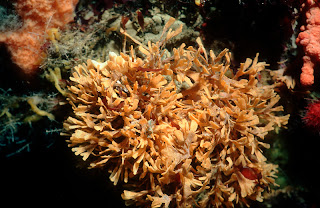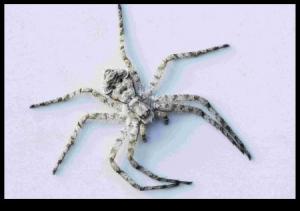Tuesday, February 22, 2011, 9:30 PM
By Benjamin Alexander-Bloch, The Times-Picayune
In the New Orleans area, panther hysteria is at fever pitch.
With residents reporting near daily sightings, you'd think we were under attack.
Truth is, the myth of the black panther in Louisiana - and throughout the United States - has a long phantom existence, according to physiologists and biologists.
Maria Davidson, the large carnivore program manager for the Louisiana Department of Wildlife and Fisheries, calmly explained that the only black panthers in existence are black jaguars found in South America and black leopards that live in Asia and Africa.
The North American black panther generally falls under the term "cryptid," a creature whose existence has been suggested but is not recognized by the scientific community and has been deemed highly unlikely. Bigfoot and the Loch Ness Monster fall under that category.
They also have been called "phantom cats," "alien big cats" (ABCs), and in certain circles, the sightings have been dubbed "panther paranoia."
And while some people, including local law enforcement officials, discuss the possibility of a black cougar in our midst, Davidson assuredly said black cougars do not exist at all. They come only in tawny and fawn colors, ranging from light gray-brown to a brownish orange.
In fact, she said, Louisiana does not have a breeding population of cougars - in any color - and that the last cougar found in the state was in 2009 and that animal was genetically linked to a population in New Mexico.
Last weekend, two panther sightings were reported, one in St. Tammany Parish and one in Plaquemines Parish. A few days earlier, a man in St. Bernard Parish said he and his wife saw one sitting a block from their garage, staring at them calmly, before darting into nearby woods.
Several other reports of sightings have streamed into Davidson's office and to the news media.
The recent fervor began several weeks ago, when a woman purportedly spotted a panther in a tree behind her house. Plaquemines Parish sheriff's officials went out with Davidson to investigate.
Davidson said she later confirmed that the footprints belonged to a dog.
Recently a photo began circulating on Facebook, and soon made its rounds on local television news channels, that a Plaquemines woman said she took on Sunday. Davidson said the photo certainly is of a house cat, likely measuring about 3 feet from nose to back of tail.
Other supposed black panther photos have come to her attention in the past few weeks, and she said all were much too blurry to decipher.
Plaquemines sheriff's Sgt. Robert Cullum went to the original black panther sighting in Phoenix on Plaquemines' east bank and has searched each day with hunter dogs, trained to track deer. He said he saw a 6-foot-long black cat.
A week or so after the original sighting, residents reported that the cat had moved south to the riverside community of Davant, and now Cullum predicted it is in the Bohemian area, farther south along the parish's east bank.
A Plaquemines sheriff helicopter still regularly circles the area.
Also chiming in, Lake Borne Levee District Police and levee contractors in the Violet area have reported panthers in the area.
And last Thursday, a couple in Violet called the St. Bernard Sheriff's Office and reported a panther near their home. St. Bernard sheriff's officials, especially after news broke about it on Monday, searched the woods there for the past two days to no avail.
Meanwhile, a Folsom couple recently reported to television media that their home surveillance cameras caught a panther on film Saturday. They have not reported it to government officials, and Davidson said on Tuesday that she yet heard of it.
Donna Davis said she now won't let her eight grandchildren out of the house at night.
"There is no refuting from this video what he is. It is very obvious, very clear," she said. "From head to tip to tail it's almost 6 feet, 7 feet and he has a girth to him like you can't believe. It's a massive, massive cat."
She and her husband Randy Davis have horses on their 20-acre property but say none has been injured. She said they have now added better lighting and are using live chickens to bait the panther in hopes of getting a better shot on film.
Erin C. Dupuis, a clinical psychologist at Loyola University, said one explanation for the recent flood of panther reports is the "availability heuristic."
The recent barrage of media reports about panther sightings scare people, thus making a significant impression on their psyche. In turn, they begin thinking about panthers more and they begin to have the impression that more black panthers exist than actually do, she explained.
"Now, when I go to my backyard I am primed to think that what I see is a black panther, even though it might just be a big cat or dog that is blurry in the side of my vision," said Dupuis, who studies how people think about their social environment.
Another explanation Dupuis posed is the "confirmation bias," which states when people think something exists, they seek out information that confirms those beliefs.
Davidson said when a pet goes missing, people often will jump to the conclusion that it was a panther, or a cougar, instead of the neighborhood dog, a coyote or an even simpler explanation: that the cat simply ran away.
"It's a phenomenon that we talk about quite often actually, just among the professionals who deal with it," Davidson said.
And after the state Wildlife and Fisheries Department debunks stories about roaming black panthers, explaining that they do not exist in the area, Davidson said people often try to find another explanation, and resort to stories about how wild, exotic pets must have sprung loose from their owners.
According to urban myth, in St. Bernard's Poydras area before Hurricane Katrina, a man owned two panthers -- one brown and one black. When the deluge came, he let the beasts loose and for the past five years they've been out in the marshes.
St. Bernard officials say no records were kept from before the storm and most of the pre-storm staff in the local animal control department have since left town, making research into the story difficult.
But, any owners of the world's six big cats -- tigers, lions, jaguars, leopards, cheetahs and cougars -- must receive a permit from Wildlife and Fisheries, and Davidson said none has been issued.
Photos and video at:
http://www.nola.com/pets/index.ssf/2011/02/panther_sightings_have_residen.html















